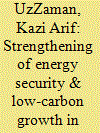| Srl | Item |
| 1 |
ID:
158318


|
|
|
|
|
| Publication |
Dhaka, Institute for Policy, Advocacy and Governance, 2017.
|
| Description |
xvi, 272p.hbk
|
| Standard Number |
9789843429247
|
|
|
|
|
|
|
|
|
|
|
|
Copies: C:1/I:0,R:0,Q:0
Circulation
| Accession# | Call# | Current Location | Status | Policy | Location |
| 059367 | 382.4/DHA 059367 | Main | On Shelf | General | |
|
|
|
|
| 2 |
ID:
078667


|
|
|
|
|
| Publication |
2007.
|
| Summary/Abstract |
The three major oil importing countries of Northeast Asia-China, Japan and South Korea-are concerned about future security of energy supplies to fuel their dynamic economic activity. Currently all three countries are highly dependent on imports of oil from the Middle East, a region with inherent political instability. Russia's rich reserves of oil and gas in Eastern Siberia and the Russian Far East offer an obvious alternative. Given the geographical proximity of Russia and its desire to increase its energy exports to Northeast Asia, there is huge potential for cooperation. So far there has been no real intra-regional cooperation and no common external policy towards Russia. Despite obvious differences between Europe and North East Asia, the European model of energy cooperation, developed over the past 50 years, offers some useful lessons.
|
|
|
|
|
|
|
|
|
|
|
|
|
|
|
|
| 3 |
ID:
168691


|
|
|
|
|
| Summary/Abstract |
Prudent demand-supply management of energy is pivotal for the energy security of the countries and transitions towards the sustainable low-carbon energy system. This study empirically investigates the existing demand-supply gaps of energy in the South-though-East Asian (StEA) countries and analyzes how the gaps can be minimized most efficiently through intraregional energy trade. Stochastic Frontier Gravity model extended with the determinants of efficiency models used for both primary energy and Renewable Energy Goods (REG) trade. The result implies that for most of the countries, intraregional export of primary energy, as well as REG, are positively influenced by Gross Domestic Products (GDP) of the exporting and importing countries. Tariff and distance adversely affect the exports while the implication of cross exchange ratio seems minimal in both cases. Regional Trade Agreements (RTA) are also found to have notable positive impact on intraregional trade. Results show that China and Thailand are the most-efficient in this intraregional primary energy export, while Bangladesh and Myanmar remain the least-efficient. China and Japan are the most-efficient in REG exports, while Bangladesh remains the least-efficient. On average, the whole region has the weighted export efficiency of 56.5% in intraregional primary energy trade and 63.1% in REG trade. The determinants of efficiency model reveals that institutional quality, better infrastructure, goods market efficiency, and technological readiness have reasonable impacts to enhance the countries’ intraregional energy trade efficiencies.
|
|
|
|
|
|
|
|
|
|
|
|
|
|
|
|